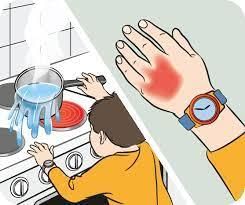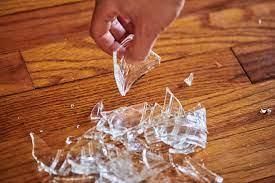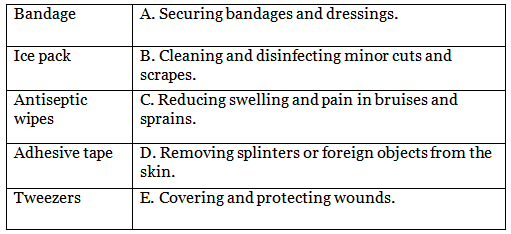Class 5 Science - Safety and First Aid - CBSE Worksheets Solutions - 2
Q1: True or False
(i) In case of severe burns with blisters, it is important to burst the blisters to release fluid.
Ans: False
Blisters should not be burst as it increases the risk of infection. Instead, cover the area with a clean cloth and get medical help.

(ii) It is safe to play with electrical outlets and plugs if your hands are dry.
Ans: False
Playing with electrical outlets and plugs can cause electric shocks, even if your hands are dry. It's important to stay safe and handle electrical devices carefully.
(iii) In the event of a nosebleed, tilt your head back to stop the bleeding.
Ans: False
Tilting the head back during a nosebleed can cause blood to flow down the throat and possibly lead to choking. The correct approach is to lean slightly forward and pinch the soft part of the nose for 5-10 minutes.
(iv) If someone is choking, you should perform the Heimlich manoeuvre immediately.
Ans: True
The Heimlich manoeuvre is a method used to remove something stuck in a person’s throat. It should be done right away if someone is choking.
(v) It is necessary to wear a helmet when riding a bicycle or skateboard.
Ans: True
Wearing a helmet while riding a bicycle or skateboard helps protect the head from injury in case of an accident.
(vi) When using a knife, it is best to cut away from your body.
Ans: True
Cutting in the opposite direction from your body reduces the risk of accidentally cutting yourself.
(vii) If you find a broken glass on the floor, you should pick it up with your bare hands.
Ans: False
When handling broken glass, it is important to use gloves or a broom and dustpan to avoid cuts and injuries.

(viii) If someone is experiencing a seizure, you should restrain them to prevent movement.
Ans: False
During a seizure, don't try to hold the person down. Instead, move things away to prevent injury and protect their head.
(ix) It is safe to mix different cleaning chemicals together to increase their effectiveness.
Ans: False
Mixing different cleaning chemicals can create dangerous fumes or cause harmful reactions. Always use chemicals according to the instructions on their labels.
(x) If someone is bitten by a venomous snake, apply a tourniquet above the bite area to prevent the venom from spreading.
Ans: False
Using a tourniquet for a snake bite can block blood flow and cause serious problems. It's better to get medical help right away.
Q2: Match the Following
 Ans:
Ans:Bandage - E. Covering and protecting wounds.
Ice pack - C. Reducing swelling and pain in bruises and sprains.
Antiseptic wipes - B. Cleaning and disinfecting minor cuts and scrapes.
Adhesive tape - A. Securing bandages and dressings.
Tweezers - D. Removing splinters or foreign objects from the skin.
Q3: Arrange in the Correct Order
Arrange the steps in the correct order for the following first aid procedures. Skip the parts that do not fit in the procedure.
(i) First Aid for a Nosebleed
(a) Avoid tilting the head back.
(b) Pinch the soft part of the nose.
(c) Lean slightly forward.
(d) Keep the head elevated for a few minutes after the bleeding stops.
Ans: c → b → d
When someone has a nosebleed, the correct order of first aid steps is to lean slightly forward, pinch the soft part of the nose, keep the head elevated for a few minutes after the bleeding stops, and avoid tilting the head back.
(ii) First Aid for a Minor Burn
(a) Apply ice to the burn immediately.
(b) Run cold water over the burn for at least 10 minutes.
(c) Pop any blisters that form.
(d) Cover the burn with a sterile non-stick bandage.
Ans: a → d → a
In the case of a minor burn, the correct order of first aid steps is to run cold water over the burn for at least 10 minutes, cover the burn with a sterile non-stick bandage, and avoid applying ice immediately.
(iii) First Aid for Choking
(a) Perform the Heimlich maneuver.
(b) Call for emergency help if the person cannot breathe or speak.
(c) Encourage the person to drink water.
(d) Pat the person's back forcefully.
Ans: b → a
If someone is choking, the first aid steps involve calling for emergency help if the person cannot breathe or speak, and then performing the Heimlich manoeuvre if necessary. Encouraging the person to drink water or patting the back forcefully are not recommended steps for choking first aid.

(iv) First Aid for a Snake Bite
(a) Apply a tourniquet above the bite area.
(b) Keep the bitten limb elevated.
(c) Wash the bite area with soap and water.
(d) Seek immediate medical attention.
Ans: c → b → d
If someone is bitten by a venomous snake, first wash the bite with soap and water, keep the affected limb raised, and get medical help immediately. Do not use a tourniquet, as it can block blood flow and cause serious problems.
(v) First Aid for Cuts and Scrapes
(a) Apply a bandage to the wound.
(b) Clean the wound with antiseptic wipes.
(c) Use tweezers to remove any debris from the wound.
(d) Elevate the injured limb.
Ans: b → c → a
For cuts and scrapes, first clean the wound with antiseptic wipes, then use tweezers to remove any dirt or debris, and finally cover it with a bandage. Raising the injured limb is not usually needed for these types of injuries.
Q4: Multiple Choice Questions (MCQs)
(i) What is the primary purpose of first aid in the case of burns?
(a) To break blisters formed on the skin.
(b) To cool the skin and prevent further damage.
(c) To apply antiseptic cream immediately.
(d) To wait for a doctor to arrive.
Ans: (b)
The primary purpose of first aid for burns is to cool the skin and prevent further damage. This is achieved by placing the burnt area under cold water.
(ii) When should you apply tincture of iodine to a wound?
(a) Before washing the wound with water.
(b) After washing the wound with water.
(c) Only if the wound is deep.
(d) Never, as it can be harmful.
Ans: (b)
Tincture of iodine should be applied to a wound after washing it with water. It helps disinfect the wound.
(iii) What is the recommended first aid for an animal bite, such as from a dog?
(a) Apply ice immediately.
(b) Wash with soap and water and apply an antiseptic lotion.
(c) Apply a paste of baking soda.
(d) Take the patient to the hospital for stitches.
Ans: (b)
For an animal bite, such as from a dog, the recommended first aid is to wash the affected area with soap and water and apply an antiseptic lotion. This helps prevent infection.

(iv) How should you provide support for a suspected fractured hand?
(a) Use a cloth sling.
(b) Apply ice to reduce swelling.
(c) Move the hand gently to prevent stiffness.
(d) Tie a tourniquet above the hand to stop blood flow.
Ans: (a)
When a suspected hand fracture occurs, support can be provided using a cloth sling. It's important not to move the fractured part and to seek medical attention immediately.
(v) What should you do when experiencing a nosebleed according to the first aid instructions?
(a) Blow your nose vigorously.
(b) Apply pressure to the back of the neck.
(c) Breathe through your nose.
(d) Sit upright with your head held back and arms folded above the head.
Ans: (d)
During a nosebleed, it's best to sit upright with your head slightly forward. This position helps reduce blood flow to the nose. You should not blow your nose, apply pressure to the back of your neck, or breathe through your nose, as these are not good first aid measures for a nosebleed.
Q5: Short Answer Questions
(i) What is the main aim of first aid?
Ans: The main purpose of first aid is to give quick and basic medical help to someone who is injured or sick until professional medical assistance arrives. The key goals of first aid are to save lives, prevent the situation from getting worse, and help the person recover.
(ii) What should we do when a cut is deep and bleeding?
Ans: When a cut is deep and bleeding, follow these steps:
- Wash your hands with soap and water to avoid infection.
- Gently clean the wound with water and mild soap, if available.
- Apply direct pressure to the wound using a clean cloth or sterile bandage to control bleeding.
- Elevate the injured area if possible, as it can help reduce bleeding.
- Once bleeding is under control, cover the wound with a sterile dressing or clean cloth.
- Seek medical help if the bleeding is severe, the wound is large, or if you are unsure about the seriousness of the injury.
(iii) What is a tourniquet?
Ans: A tourniquet is a tool used to stop heavy bleeding from an arm or leg. It is usually a wide band made of fabric, rope, or similar material. Tourniquets are placed above the injury (closer to the body) to limit blood flow to the hurt limb. They should only be used as a last resort when other methods, like applying direct pressure, haven’t worked. After using a tourniquet, it's important to get medical help right away.
(iv) What do you mean by a fracture? What first aid should be given to the victim of a fracture?
Ans: A fracture is a break or a crack in a bone. It can be a result of an accident, fall, or any forceful impact. First aid for a fracture involves the following steps:
- Encourage the injured person to stay as still as possible to prevent further injury.
- Call for emergency medical help immediately.
- If there is an open wound, cover it with a clean cloth or sterile dressing.
- Apply ice packs wrapped in cloth to the injured area to reduce swelling and pain.
- Immobilize the injured limb by using splints or improvised materials (for eg., rolled-up newspapers, and boards) to keep the broken bone from moving.
- Do not try to realign the bone; leave it to medical professionals.
(iv) Suggest the first aid to be given for nose bleeding.
Ans: For nose bleeding, follow these first aid steps:
- Ask the person to sit down and lean slightly forward to avoid swallowing blood.
- Pinch the soft part of the nose (just below the bridge) using your thumb and index finger.
- Maintain pressure on the nose for at least 10-15 minutes without releasing it. This helps to stop the bleeding.
- Apply a cold compress or ice pack wrapped in a cloth to the bridge of the nose to help constrict blood vessels and reduce bleeding.
- Avoid tilting the head backwards, as this can cause blood to flow down the throat.
- If the nosebleed continues for more than 20-30 minutes, or if it's a result of a severe injury, seek medical help immediately.
|
42 videos|230 docs|45 tests
|
FAQs on Class 5 Science - Safety and First Aid - CBSE Worksheets Solutions - 2
| 1. What are the basic first aid steps I should know for minor injuries? |  |
| 2. How can I treat a burn at home? |  |
| 3. What should I do if someone is choking? |  |
| 4. When should I call emergency services for a medical issue? |  |
| 5. What is the importance of knowing CPR? |  |
















